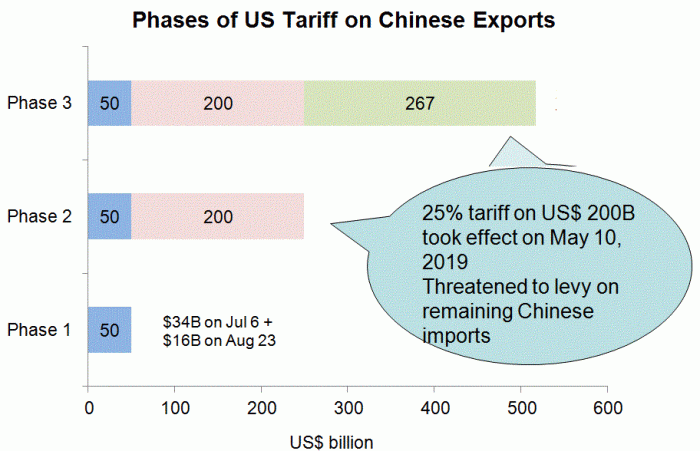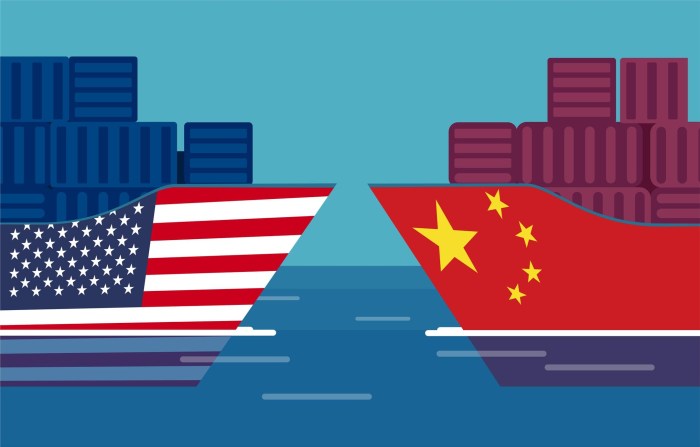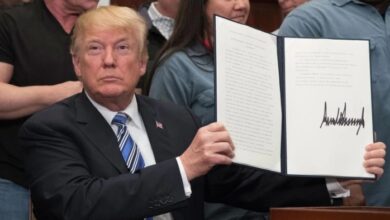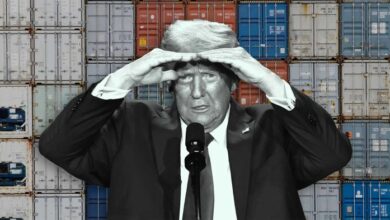
China retaliatory tariffs US trade war ignited a global economic firestorm. This complex issue, spanning decades of trade relations, involved a delicate dance of tariffs, political maneuvering, and economic repercussions. Understanding the historical context, the mechanisms of these tariffs, and the broader economic and political consequences is crucial to grasping the full impact of this trade war.
From the initial trade imbalances to the escalating tensions, this analysis explores the key factors that fueled the conflict. The intricate web of global supply chains, the specific industries affected, and the evolving public opinions further complicate the story.
Historical Context of US-China Trade Relations
The US-China trade relationship, a complex tapestry woven with threads of cooperation and contention, has profoundly shaped the global economic landscape. From initial engagement to the escalating trade war, the relationship’s evolution has been marked by significant shifts in trade policies, imbalances, and the pursuit of economic interests. This exploration delves into the historical context, tracing key events, agreements, and disputes.The relationship has evolved from a period of cautious engagement to a more complex dynamic characterized by trade imbalances and, at times, aggressive trade policies.
Understanding this history is crucial to comprehending the current challenges and potential future trajectories of the relationship.
Timeline of Significant Trade Events
The trade relationship between the US and China has a long history, marked by various phases of cooperation and conflict. Early engagement was characterized by a gradual opening of the Chinese economy and increasing trade volumes.
- 1979: Establishment of diplomatic relations between the US and China marked a turning point, paving the way for increased trade. This opened a new era of potential for both nations.
- 1980s-1990s: Gradual increase in trade volume and investment, primarily driven by China’s economic reforms and the US desire for access to a large market.
- 2001: China’s accession to the World Trade Organization (WTO) significantly expanded trade flows, with the US benefiting from access to a vast consumer market. This event led to a dramatic shift in the global trade landscape.
- 2000s-2010s: Growing trade imbalances, with China accumulating substantial surpluses and the US facing increasing trade deficits. This imbalance raised concerns about unfair trade practices and potential negative impacts on US jobs.
- 2018-present: Imposition of tariffs and other trade restrictions by both the US and China. This escalating trade war has impacted global supply chains, investment, and economic growth.
Evolution of Trade Imbalances, China retaliatory tariffs us trade war
The trade relationship between the US and China has been marked by significant trade imbalances. The shift in economic power from the US to China has played a pivotal role.
China’s rapid economic growth, coupled with its export-oriented model, led to a widening trade deficit for the US. This was fueled by a substantial gap in manufacturing costs between the two nations, resulting in a surge of imports from China into the US market. The US, on the other hand, experienced a growing trade deficit, particularly in manufacturing sectors.
History of Trade Restrictions and Tariffs
Both nations have implemented trade restrictions and tariffs throughout their trade relationship. These actions have often been driven by concerns about unfair trade practices, intellectual property theft, and the protection of domestic industries.
- US Trade Restrictions: The US has historically imposed various trade restrictions on China, often related to intellectual property rights, export controls, and alleged unfair trade practices.
- China’s Trade Restrictions: China has also implemented trade restrictions and tariffs, aimed at protecting domestic industries and promoting its own economic interests. These restrictions can be complex and nuanced.
Comparison of Trade Policies
The following table summarizes the different trade policies adopted by the US and China.
| Characteristic | US | China |
|---|---|---|
| General Approach | Protectionist measures to safeguard domestic industries, promoting fair trade | Protectionist policies to foster domestic growth and strategic industries, focusing on economic self-sufficiency |
| Focus | Maintaining a level playing field, addressing trade imbalances, and ensuring fair competition | Promoting domestic industries, encouraging exports, and achieving strategic self-reliance |
| Specific Policies | Tariffs, anti-dumping measures, subsidies, and sanctions | Government subsidies, industrial policies, and strategic investments |
Mechanisms of Retaliatory Tariffs
Retaliatory tariffs, a common tactic in trade disputes, are essentially taxes imposed on imported goods. These tariffs aim to punish a trading partner for perceived unfair trade practices, often in response to similar actions by that partner. Understanding the mechanisms behind these tariffs is crucial to grasping their impact on global commerce and domestic economies.Tariffs are implemented through a series of steps.
First, a government identifies specific imported goods that it wishes to target. Next, it sets a tariff rate, often a percentage of the import’s value. These rates are then published, and customs authorities enforce the levy at the point of entry into the country. This process can vary depending on the specific rules and regulations of each nation.
China’s retaliatory tariffs during the US trade war are a complex issue, impacting global markets. Cleaning up the mess left by these trade disputes is a huge challenge, but it’s important to address the underlying issues. Fortunately, there are effective ways to tackle the bacteria lurking in your home, which, surprisingly, has some parallels to the economic complexities of international trade disputes.
For detailed cleaning tips, check out this helpful guide on what to clean house bacteria. Ultimately, navigating these economic battles requires careful consideration and a strategic approach, just like tackling the microscopic threats in your home.
Tariff Implementation Process
The process typically involves a government agency like a customs authority identifying specific goods from the targeted country. This agency then publishes a schedule outlining the tariff rates that will be applied. Importantly, these tariffs are often applied unilaterally, meaning one country imposes them without the other country’s explicit consent. The tariffs are then enforced by customs officials at the border, who collect the duty from importers.
Impact on Import Prices and Consumer Costs
Tariffs directly increase the price of imported goods. When a tariff is imposed, the cost of the imported product rises. This price increase is then passed on to consumers, making the product more expensive. For example, a 10% tariff on imported steel will increase the price of steel products for consumers. This effect can be significant, especially for products with no or limited domestic substitutes.
The impact on consumer costs depends on the elasticity of demand for the product and the availability of domestic alternatives.
Impact on Domestic Industries and Employment
Retaliatory tariffs can have a complex effect on domestic industries. In some cases, tariffs can shield domestic industries from foreign competition, making it easier for them to compete. This can lead to increased employment and profits in these industries. However, tariffs can also hurt domestic industries in other ways. For instance, if a country’s industries rely heavily on imported inputs, tariffs can increase production costs and reduce competitiveness in global markets.
This, in turn, can reduce domestic employment. Moreover, retaliatory tariffs can trigger a trade war, harming all parties involved.
Illustrative Table of Tariff Impact
| Sector | US Impact (Example) | China Impact (Example) |
|---|---|---|
| Steel | Increased prices for steel products, potentially leading to higher construction costs, reduced competitiveness for US steel producers. | Increased prices for imported steel, reduced competitiveness for Chinese steel users (e.g., auto manufacturers), possible job losses. |
| Electronics | Higher prices for imported electronics, potentially impacting consumer spending. | Higher prices for imported components, potentially impacting production costs for Chinese electronics manufacturers. |
| Agricultural Products | Increased prices for imported agricultural products, affecting consumer food prices. | Reduced export opportunities for Chinese agricultural products, affecting farmer incomes. |
Economic Consequences of the Trade War
The US-China trade war, initiated in 2018, had far-reaching economic consequences, impacting businesses, supply chains, and global trade patterns. While the initial goals of the trade war were to address perceived unfair trade practices and protect American industries, the actual effects were multifaceted and often unpredictable. The ripple effects extended beyond the direct participants, influencing various sectors and regions across the globe.The trade war’s impact wasn’t simply a matter of tariffs increasing prices; it created a complex web of economic adjustments and uncertainties that extended far beyond the immediate trade partners.
The resulting volatility in global markets highlighted the interconnectedness of the global economy and the potential for unintended consequences of protectionist policies.
Short-Term Economic Effects on US and Chinese Businesses
The imposition of tariffs led to immediate price increases for imported goods, impacting consumers and businesses alike. US companies relying on Chinese imports faced higher input costs, potentially reducing profitability or prompting them to seek alternative suppliers. Simultaneously, Chinese businesses saw a decline in export revenue, leading to potential job losses and reduced investment. The uncertainty surrounding the trade war created a climate of caution and reduced investment in both countries.
Long-Term Economic Implications on Global Supply Chains and Trade Patterns
The trade war’s long-term consequences involved a restructuring of global supply chains. Companies began diversifying their sourcing strategies, seeking alternatives to Chinese suppliers. This shift had a profound impact on production costs and the efficiency of global trade. The fragmentation of supply chains increased complexity and transportation costs, impacting the overall competitiveness of various industries.
Effect on Specific Industries
- Manufacturing: The tariffs directly impacted manufacturing industries reliant on imported components from China. For example, the automotive industry saw increased costs for parts, leading to potential price increases for consumers and a decrease in overall competitiveness.
- Technology: The technology sector, particularly those companies reliant on Chinese manufacturing or sourcing, felt the brunt of the tariffs. The disruption in the supply chain for semiconductors, components, and other technology products impacted innovation and production cycles.
- Agriculture: American agricultural exports to China were significantly affected. Farmers in states like Iowa and others experienced decreased sales, leading to economic hardship for individual producers and potentially impacting overall agricultural output.
Comparative Analysis of Economic Impacts on Different Regions within the US and China
The economic effects of the trade war were not uniform across different regions within the US and China. Coastal regions in China, heavily reliant on export-oriented industries, bore the brunt of the impact. Similarly, US regions with strong ties to industries like manufacturing and agriculture experienced disproportionate economic hardship. The impact varied depending on the specific industry and the region’s reliance on trade with China.
Regional Disparities in Economic Impact
| Region | Impact |
|---|---|
| Coastal China (Export-Oriented) | Significant decline in export revenue, job losses, and reduced investment. |
| Interior China (Manufacturing Hubs) | Reduced demand for manufactured goods, potentially leading to factory closures or reduced production. |
| US Manufacturing Belt | Increased input costs, potential job losses, and reduced profitability for companies reliant on Chinese imports. |
| US Agricultural States | Decreased sales to China, financial hardship for farmers, and potential reduction in agricultural output. |
Political and Diplomatic Dimensions
The US-China trade war wasn’t solely an economic conflict; it deeply intertwined with political motivations and diplomatic maneuvering. Underlying economic disputes were often amplified by geopolitical anxieties and differing visions of global leadership. Understanding the political motivations behind the tariffs and the diplomatic efforts to resolve them is crucial to comprehending the full scope of this complex event.
Political Motivations Behind Tariffs
The imposition of tariffs wasn’t simply about economic gain; it reflected broader political objectives. Both sides perceived the other’s trade practices as unfair and detrimental to their national interests. The US, for instance, accused China of unfair trade practices, intellectual property theft, and forced technology transfer. These accusations were intertwined with broader strategic concerns about China’s growing economic and military influence.
China, in turn, viewed the tariffs as a politically motivated attempt to contain its rise. The US saw this as a strategic threat to its global economic dominance.
Role of Political Factors in Escalation and De-escalation
Political considerations played a significant role in shaping the trajectory of the trade war. Domestic political pressures, particularly in the US, influenced the administration’s approach. The desire to protect American industries and jobs, as well as the political expediency of taking a tough stance against China, contributed to the escalation. Conversely, the potential for economic harm to both countries, and the global economic implications, eventually prompted de-escalation efforts.
Political shifts in leadership and evolving global dynamics also played a crucial role in finding common ground.
Diplomatic Efforts to Resolve Trade Disputes
Numerous diplomatic efforts were undertaken to mitigate the trade war’s impact. These included high-level talks, negotiations, and international cooperation. The US and China held numerous rounds of trade negotiations, often characterized by periods of progress followed by setbacks. The involvement of other countries and international organizations also contributed to efforts to find common ground. The ultimate success of these efforts remained contingent on the willingness of both sides to compromise and address the core issues at hand.
Key Diplomatic Actors and Their Roles
| Diplomatic Actor | Role in Addressing the Trade War |
|---|---|
| United States Trade Representative (USTR) | Led negotiations and represented US interests in trade disputes. |
| Chinese Ministry of Commerce | Represented Chinese interests and participated in trade negotiations. |
| The Office of the US President | Oversaw and coordinated overall US policy on trade with China. |
| World Trade Organization (WTO) | Provided a forum for dispute resolution and adherence to international trade rules. |
| Other International Organizations (e.g., IMF, G20) | Played a role in facilitating discussions and providing support for resolving the trade dispute. |
Global Impact of the Trade War

The US-China trade war, a complex and multifaceted conflict, reverberated far beyond the shores of these two economic giants. Its consequences were felt across the globe, impacting international trade flows, market stability, and the economies of numerous countries. The ripple effects of tariffs and retaliatory measures extended to industries and individuals worldwide, highlighting the interconnected nature of the global economy.
Ripple Effects on Global Trade
The imposition of tariffs by both the US and China disrupted established trade patterns. Companies faced increased costs, supply chain disruptions, and uncertainty about future market conditions. This uncertainty, in turn, discouraged investment and hindered economic growth in various sectors. For example, manufacturers relying on components from China experienced production delays and higher input costs, potentially impacting their competitiveness in international markets.
Influence on International Markets and Economic Stability
The trade war created volatility in international markets. Investor confidence waned, leading to fluctuations in stock prices and currency exchange rates. This instability extended beyond the US and China, affecting markets in Europe, Asia, and Latin America. The uncertainty about the future direction of trade relations made it difficult for businesses to plan and invest, which ultimately hindered global economic growth.
China’s retaliatory tariffs during the US trade war were a significant blow, impacting both economies. Navigating such complex situations often requires a measured response, similar to how one might respond to an apology. Learning how to respond effectively to a perceived offense, as detailed in this helpful guide on how to respond apology , can be applied to the broader strategy of managing international trade disputes.
Ultimately, finding common ground and resolving trade tensions is crucial for both countries, just as it is in personal relationships.
Impact on Other Countries’ Economies and Trade Relationships
The trade war’s impact was not confined to the US and China. Other countries experienced varied consequences. Some, heavily reliant on trade with either the US or China, suffered declines in exports and economic activity. For instance, countries that exported significant amounts of goods to China experienced reduced demand and export revenue. Conversely, some countries benefited from shifting trade patterns, though these benefits were often temporary and came at the cost of economic instability in other regions.
The trade war’s impact on international trade relationships also altered established partnerships and alliances, with nations seeking new trade agreements and strategic partnerships to mitigate the risks associated with the volatile global landscape.
Impact on International Investment and Trade Flows
The trade war significantly affected international investment and trade flows. Uncertainty surrounding trade policies discouraged foreign direct investment (FDI) in both the US and China, as companies were hesitant to commit resources to projects with uncertain returns. Furthermore, the trade war caused companies to re-evaluate their supply chains, seeking to diversify their sources of inputs and reduce dependence on specific regions.
This led to a shift in investment towards alternative locations, often resulting in a complex reconfiguration of global production networks. This dynamic shift is best exemplified by the re-evaluation of supply chain strategies and the subsequent relocation of manufacturing facilities to countries with more stable trade policies.
Public Opinion and Societal Impact

The US-China trade war, a complex interplay of economic and geopolitical forces, significantly impacted public opinion and societal structures in both nations. Public perception, shaped by media narratives, government pronouncements, and personal experiences, often diverged from the nuanced realities of the trade dispute. The war’s effects reverberated through the economies, causing job losses, economic hardship, and shifts in consumer behavior.
This section delves into the public perception and societal impact of the trade war in both the US and China, highlighting the role of public opinion in shaping government policies.
China’s retaliatory tariffs during the US trade war were a significant part of the escalating tensions. Understanding the complexities of the US-China trade relationship requires looking at the trade balance, specifically the surplus, exports, and imports. A deeper dive into the subject, including the role of tariffs under the Trump administration, can be found in this insightful article on the us china trade balance surplus exports imports tariffs trump issue.
Ultimately, these retaliatory tariffs significantly impacted both economies, highlighting the delicate balance of global trade.
Public Perception in the US
The US public’s perception of the trade war was multifaceted. Initial support for tariffs, often framed as a way to protect American industries and jobs, waned as the economic consequences became apparent. Many Americans, particularly those in affected sectors, experienced direct financial repercussions, leading to concerns about the trade war’s overall economic impact. Reports and news articles often highlighted the rising prices of consumer goods, reflecting the tangible impact on everyday life.
While some segments of the public remained supportive of protectionist measures, the overall sentiment shifted towards a more critical view as the trade war’s long-term consequences unfolded.
Public Perception in China
Public opinion in China was largely shaped by the government’s narrative, emphasizing the resilience of the Chinese economy and the negative impact of US tariffs on Chinese businesses and consumers. Nationalist sentiment played a significant role, with many Chinese citizens feeling the trade war was an attempt to contain China’s economic growth. This perspective, often reinforced by state-controlled media, fostered a sense of national unity and resolve in the face of perceived external pressure.
However, there were also concerns about the trade war’s impact on specific sectors and regions of the country, though these were generally less publicized than the national narrative.
Societal Impact in the US
The trade war’s societal impact in the US manifested in several ways. Sectors reliant on Chinese imports, such as manufacturing and agriculture, experienced job losses and reduced profitability. Consumer prices rose, affecting households across the income spectrum. The uncertainty surrounding the trade war’s trajectory also contributed to economic anxiety and impacted consumer confidence. Furthermore, the trade war exposed vulnerabilities in supply chains, raising concerns about the long-term economic security of the US.
Societal Impact in China
The societal impact of the trade war in China was equally significant. Specific industries, particularly those exporting to the US, faced production declines and job losses. The export-oriented nature of some Chinese regions led to substantial economic hardship in those areas. While the Chinese government implemented stimulus measures, the overall economic growth rate slowed. However, the Chinese government’s proactive response, including investments in domestic industries and infrastructure projects, helped mitigate the immediate impact.
Role of Public Opinion in Shaping Government Policies
Public opinion, while not the sole determinant, significantly influenced government policies regarding the trade war. The shifting sentiment in both the US and China, reflected in public polls and media coverage, played a role in the decision-making process. Political pressure from constituents and interest groups further shaped policy decisions, forcing a delicate balancing act between protecting domestic industries and addressing the economic repercussions of the trade war.
Comparison of Public Responses
| Characteristic | US | China |
|---|---|---|
| Initial Sentiment | Support for tariffs, protectionism | Nationalist sentiment, resilience |
| Shifting Sentiment | Growing concern about economic consequences | Focus on government response and resilience |
| Impact on Policy | Pressure to address economic concerns | Emphasis on internal measures to mitigate the impact |
| Media Influence | Diverse media landscape, varied narratives | State-controlled media, unified narrative |
Alternative Trade Strategies and Solutions: China Retaliatory Tariffs Us Trade War
The US-China trade war, marked by escalating tariffs and retaliatory measures, highlighted the complexities and limitations of traditional trade conflict resolution. The economic and geopolitical consequences underscored the need for alternative strategies that could foster a more sustainable and mutually beneficial trade relationship. These alternatives move beyond the zero-sum game mentality often associated with trade wars, seeking common ground and collaborative solutions.
Exploring Alternative Trade Negotiation Strategies
Various approaches could have been employed to de-escalate the trade tensions. Diplomacy, rather than punitive tariffs, could have been prioritized. This approach would involve engaging in constructive dialogue to identify areas of common interest and find mutually acceptable solutions. Facilitated by neutral parties or international organizations, such as the WTO, these negotiations could focus on addressing specific concerns and establishing clear guidelines for future trade relations.
Potential Solutions for Managing Trade Tensions
Several strategies could be implemented to manage future trade tensions between the US and China. These include establishing clear and transparent trade rules, promoting fair competition, and implementing dispute resolution mechanisms. Implementing transparent regulations on intellectual property rights and ensuring adherence to international standards would help build trust and prevent future disputes. Regular consultations and dialogue between the two nations on trade-related issues are crucial to preventing escalation and fostering mutual understanding.
International Agreements and Collaborations
International agreements and collaborations are vital in mitigating the impact of future trade conflicts. The WTO, with its established dispute settlement mechanisms, plays a critical role in this process. A strengthened WTO, with updated rules reflecting current economic realities, can help resolve trade disputes fairly and efficiently. Bilateral agreements, focused on specific areas of concern, can complement the work of international organizations, addressing concerns like intellectual property protection or market access in a more tailored manner.
Advantages and Disadvantages of Various Negotiation Strategies
| Negotiation Strategy | Advantages | Disadvantages |
|---|---|---|
| Diplomacy and Dialogue | Promotes understanding, fosters cooperation, can lead to mutually beneficial agreements, potentially avoiding escalation. | Can be time-consuming, may not always be effective, requires significant trust and goodwill from both parties. |
| Targeted Sanctions/Retaliation | Can pressure a party to change behavior, can be effective in specific cases. | Can escalate conflict, can harm innocent parties, may not always achieve desired outcomes, often viewed negatively by international community. |
| International Arbitration/Mediation | Provides neutral framework for dispute resolution, promotes adherence to international law. | Can be slow, may not fully address underlying concerns, requires agreement from both parties to participate. |
| Trade Liberalization | Reduces trade barriers, increases economic efficiency, creates new market opportunities. | May not be suitable for all situations, can create winners and losers, requires political will from both sides to implement. |
Illustrative Examples of Tariffs
The US-China trade war, a complex and multifaceted conflict, saw the imposition of tariffs on a wide array of goods. These tariffs aimed to pressure China on various trade practices, but their impact rippled through global supply chains and economies. Understanding these specific examples is crucial to comprehending the far-reaching consequences of the trade war.Tariffs, essentially taxes on imported goods, can be a potent tool in international trade disputes.
However, they are rarely a simple solution, often leading to retaliatory measures and unintended consequences. The targeted industries and products faced significant disruptions, leading to economic instability and uncertainty.
Specific Tariffs Imposed
The imposition of tariffs wasn’t a uniform action; rather, it involved a series of escalating retaliatory measures. The US frequently targeted Chinese products deemed to be unfairly subsidized or produced through intellectual property theft. This led to a cycle of tariffs, with each side imposing further levies on the other’s exports.
Impact on Targeted Industries
Tariffs significantly impacted various industries in both the US and China. Industries heavily reliant on imports from China, like consumer goods, electronics, and manufacturing, faced increased costs, potentially reducing their competitiveness. Similarly, Chinese industries reliant on exporting to the US saw their sales and profits diminish.
Illustrative Table of Tariffs
| Tariff | Impacted Products | Resulting Effects |
|---|---|---|
| 25% tariff on $50 billion worth of Chinese goods (2018) | Smartphones, computers, consumer electronics, clothing | Increased prices for American consumers, potential job losses in US manufacturing, and supply chain disruptions. |
| 25% tariff on $200 billion worth of Chinese goods (2018) | Machinery, industrial equipment, and a broader range of consumer goods | Further escalation of trade tensions, impacting numerous US industries, and contributing to increased inflation. |
| 15% tariff on $300 billion worth of Chinese goods (2019) | Toys, textiles, and other consumer goods | Further inflationary pressures, impacting retail prices for American consumers, and significant impact on import-dependent US industries. |
| 10% tariff on imported Chinese goods (2020) | Farm products, machinery, and consumer goods | Continued trade tension, but a gradual shift towards a more stable relationship, along with an attempt to manage the impact of tariffs on specific industries. |
Impact on Specific Industries
The US-China trade war, marked by escalating tariffs, significantly impacted various industries across both countries. The ripple effects extended beyond the immediate trading partners, affecting global supply chains and economic stability. Understanding the specific impacts on sectors like technology, agriculture, manufacturing, and consumer goods is crucial to comprehending the far-reaching consequences of this trade conflict.
Technology Sector
The technology sector, a cornerstone of both economies, bore the brunt of the trade war. Tariffs on technology products, including semiconductors and telecommunications equipment, disrupted supply chains and increased production costs for companies operating in both nations. This led to job losses in manufacturing and research and development, especially in sectors heavily reliant on imported components. The trade war also exacerbated existing geopolitical tensions, prompting concerns about technology security and intellectual property theft.
Companies faced increased uncertainty and had to adjust their strategies to navigate the complexities of the trade conflict.
Agricultural Exports
Agricultural exports, particularly from the United States, experienced substantial losses. China, a major consumer of agricultural products, imposed tariffs on various US agricultural goods, including soybeans, pork, and wheat. Farmers in the affected regions faced financial hardship due to reduced demand and lower prices. The impact was widespread, impacting not just the farmers themselves but also related industries such as processing and transportation.
The trade war highlighted the vulnerability of agricultural sectors to international trade disputes.
Manufacturing and Consumer Goods
The manufacturing sector, encompassing a vast array of goods, was directly affected by tariffs. Companies faced higher input costs, leading to increased prices for consumers. This, in turn, impacted consumer spending and demand for manufactured goods. The trade war fostered a more complex global trade environment, influencing the production and distribution of consumer goods, which often rely on international supply chains.
Specific Impacts Across Sectors
| Industry | Impact on US | Impact on China |
|---|---|---|
| Technology | Reduced exports, higher production costs, job losses in manufacturing and R&D | Increased import costs, disruption of supply chains, potential for reduced innovation |
| Agriculture | Reduced demand, lower prices, financial hardship for farmers, loss of market share | Increased import costs, potential for food shortages, higher consumer prices |
| Manufacturing | Increased input costs, reduced competitiveness, potential for job losses | Reduced exports, disruption of supply chains, potential for lower production levels |
| Consumer Goods | Higher prices for consumers, reduced choices, potential for inflation | Higher prices for consumers, potential for reduced purchasing power |
Closing Summary
The China retaliatory tariffs US trade war ultimately demonstrated the complexities of international trade and the interconnectedness of global economies. While specific solutions remain elusive, the historical context and ongoing analysis of the economic, political, and social consequences offer valuable insights into navigating future trade conflicts. Examining alternative strategies, potential solutions, and the broader global impact highlights the need for diplomatic solutions and a focus on sustainable trade practices.





